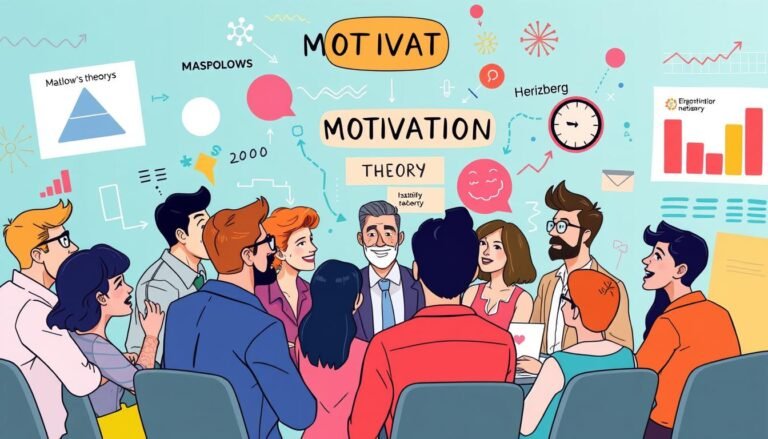Organizational Development: A Psychological Approach to Business Growth
Ever wondered why some companies do great while others lag behind? The answer might be in something called organizational development (OD). This method combines business psychology and strategic planning to boost performance and growth.
OD is more than just a trendy term. It’s a science-backed field that uses psychology, social sciences, and HR. It aligns strategy, structure, people, and processes to enhance capabilities and solve big problems.
Unlike old-school business tactics, OD looks at the whole picture. It focuses on culture, innovation, and adult learning for lasting change. This approach aims to make organizations more effective and improve performance.
In today’s fast business world, OD is key for staying ahead. It provides a structured way to tackle challenges, adapt to changes, and build a positive work culture. This culture encourages growth and success.
Key Takeaways
- OD integrates psychology and business strategies for growth
- It aligns company structure, people, and processes
- OD focuses on long-term, systematic improvements
- It addresses organizational culture and innovation
- OD helps companies adapt to rapid business changes
- It aims to boost effectiveness and overall performance
Understanding the Essence of Organizational Development
Organizational development (OD) is a key way to grow businesses. It aims to make companies better by changing them in smart ways. This mix of psychology and business helps improve how well a company works.
Defining Organizational Development
OD is about making a company better and healthier. It involves planning, making changes, and checking how well those changes work. It looks at the whole company, from how happy employees are to how well things run.
The Psychological Foundation of OD
OD is based on psychology. It studies how people act and work together in companies. This helps create plans that meet employees’ needs, leading to better changes and growth.
Key Objectives of Organizational Development
The main goals of OD include:
- Enhancing organizational effectiveness
- Fostering innovation and adaptability
- Improving employee satisfaction and engagement
- Streamlining processes for better efficiency
- Building a positive organizational culture
By working on these goals, OD can make big improvements in business performance. It helps companies grow in a lasting way.
The Psychology Behind Successful Business Growth
Business psychology is key to making companies grow. It focuses on how employees behave and feel. This helps businesses grow in ways that traditional methods can’t.
It’s important to understand how employees work with systems. Business psychologists aim to boost motivation and engagement. This is crucial for learning and growing as a team.
They use insights into human behavior to make strategies that meet employee needs. This approach helps businesses grow.
Studies reveal that successful entrepreneurs share certain traits:
- Deep passion for their work
- Strong confidence in their abilities
- Openness to new experiences
- A rebellious spirit that challenges norms
These traits help entrepreneurs face challenges and spark innovation. By nurturing these qualities, businesses can grow and succeed.
“Greed is good. Greed is right; greed works.” – Gordon Gecko, Wall Street
While ambition is important, it must be balanced. Too much focus on wealth can harm. Instead, focusing on employee happiness and a positive culture leads to lasting success.
Organizational Development vs. Traditional Business Approaches
The business world is changing fast, and companies must keep up. Traditional MBA methods focus on money and efficiency. But, organizational development (OD) looks at the whole picture. This new way of thinking is changing how businesses grow and succeed.
Comparing OD with MBA Perspectives
MBA programs usually focus on money and how things work. OD, on the other hand, uses business psychology for a broader strategy. This shows in how each tackles business problems:
| Aspect | Traditional MBA Approach | Organizational Development Approach |
|---|---|---|
| Focus | Financial metrics, operational efficiency | Employee engagement, organizational culture |
| Decision Making | Top-down, hierarchical | Collaborative, involving all levels |
| Change Management | Directive, often reactive | Proactive, continuous improvement |
| Success Metrics | Profit margins, market share | Employee satisfaction, innovation rates |
The Unique Lens of Business Psychology
Business psychology offers a special view in OD. It looks at what makes people successful, like motivation and teamwork. This approach has shown great results:
- Companies using OD see a 47% boost in employee engagement
- OD-focused organizations see a 21% jump in profits
- OD practices lead to a 35% drop in employee leaving
These numbers show how business psychology can make a big difference. By focusing on people and culture, companies can grow in a lasting way. They can also handle the challenges of today’s world better.
As things get more complex, OD is a smarter way to succeed. By mixing MBA knowledge with business psychology, companies can build strong, flexible, and successful cultures. These cultures are ready to excel in today’s fast-changing business world.
The Five Phases of Organizational Development Strategy
An effective OD strategy unfolds in five key phases. This structured approach ensures a comprehensive and impactful organizational development process. Let’s explore each phase in detail.
Entry: Establishing Initial Contact
The entry phase marks the beginning of the OD process. During this stage, consultants meet with key stakeholders to define project scope and establish expectations. This critical step sets the foundation for a successful organizational assessment.
Diagnosis: Collaborative Data Gathering
In the diagnosis phase, consultants work closely with employees to collect relevant data. This collaborative approach helps identify areas needing improvement, such as customer complaints or employee turnover. The Reddy’s Cube method is often used to categorize interventions based on focus, intensity, and type.
Feedback: Information Analysis and Action Planning
The feedback phase involves analyzing gathered data and creating action plans. Consultants present findings to management and develop strategies for addressing identified issues. This stage is crucial for aligning organizational goals with proposed changes.
Solution: Implementing Change Initiatives
During the solution phase, change management strategies are put into action. This may include leadership development programs, process improvements, or culture transformation initiatives. For example, Amazon plans to invest $700 million in organizational development and retrain a third of its workforce by 2025.
Evaluation: Continuous Assessment and Improvement
The final phase involves ongoing evaluation of implemented changes. Kirkpatrick’s Four Levels of Evaluation is a popular framework for measuring the effectiveness of OD interventions. This continuous assessment ensures that the OD strategy remains aligned with organizational goals and adapts to changing needs.
| Phase | Key Activities | Importance |
|---|---|---|
| Entry | Define scope, establish expectations | Sets foundation for success |
| Diagnosis | Collect data, identify issues | Reveals areas for improvement |
| Feedback | Analyze data, create action plans | Aligns goals with changes |
| Solution | Implement change initiatives | Drives organizational transformation |
| Evaluation | Assess outcomes, make adjustments | Ensures long-term effectiveness |
Key Initiatives in Organizational Development
Organizational development (OD) initiatives help businesses grow. They improve employee skills, processes, and work culture. Let’s look at some successful OD efforts and their effects.
Team building is key in OD. Volvo made job changes to reduce staff turnover and absences. This move improved work conditions and boosted productivity.
Organizational restructuring can also bring big wins. Corning revamped its mold machine shop, cutting costs and increasing profits. WhatsApp cut costs by outsourcing app development, helping it grow to over 2 billion users.
Engaging employees is vital for success. PwC’s My + people strategy attracts and keeps top talent with flexibility and well-being support. Brother made its career site more engaging, leading to more applications.
- Walmart’s Live Better U program offers free skills training and education
- Microsoft automated leadership development training
- Marriott International’s Voyage program develops future leaders through hands-on experiences
These efforts show how OD can change organizations for the better. By focusing on team building, restructuring, and engaging employees, companies can become more productive and innovative.
The Role of Change Management in OD
Change management is key in organizational development (OD). It connects planning to successful change implementation. Studies show projects with good change management succeed seven times more than those without.
Overcoming Resistance to Change
Resistance to change is a big challenge in OD. Employees might like the current way or fear the new. Change managers use clear talks and involve everyone to tackle this.
They listen to each person’s worries and solve them early on.
Implementing Effective Change Strategies
Good change strategies mix big plans with action details. OD experts create plans for the big picture, while change management helps with the small steps. This way, more people adopt changes, projects get better returns, and work gets done faster.
For instance, in a healthcare merger, OD might work on matching company cultures. Change management would handle the practical steps of merging systems and processes. This teamwork makes the transition smooth and keeps things running.
By adding change management to OD, companies build a strong and flexible team. This helps with current changes and gets ready for future ones.
Leadership Development and Organizational Learning
Leadership development and learning are key to a business’s success. They drive growth, encourage new ideas, and improve continuously. Companies that invest in these areas see big benefits, like happier employees and better finances.
The U.S. Bureau of Labor Statistics shows how important leadership training is. Training managers make $111,340 a year on average. Their jobs are expected to grow 8% by 2028. This shows how much value companies put on developing strong leaders.
Learning within an organization is closely tied to leadership development. It helps all employees grow and help the company succeed. This way, companies have a steady flow of skilled leaders ready to step up.
Many schools offer programs in these critical areas. For example, some offer a Master’s in Organizational Leadership and Learning. These programs need 30 credits and cover key leadership and development topics.
| Program Type | Credits Required | Tuition (per credit hour) |
|---|---|---|
| On-campus Master’s | 30 | $1,905 |
| Online Master’s | 30 | $1,230 |
These programs are flexible, with online options that mix live and recorded classes. This lets working people improve their skills without stopping their careers. It makes it easier for companies of all sizes to manage their talent.
Employee Engagement and Culture Transformation
Creating a positive organizational culture is key to business success. It drives employee engagement and workplace satisfaction. Companies that prioritize culture see remarkable results.
Fostering a Positive Organizational Culture
A strong organizational culture boosts employee morale and productivity. In fact, employees in robust cultures rate their company’s qualities 20% higher. These qualities include collaboration and work environment. 90% of staff in strong cultures express confidence in their leadership team.
Strategies for Enhancing Employee Engagement
Employee engagement is crucial for organizational growth. Engaged workers are more likely to stay, reducing turnover costs. Strategies to boost engagement include:
- Transparent communication during changes
- Involving staff in planning and problem-solving
- Offering training and development programs
- Recognizing and rewarding desired behaviors
Measuring and Improving Employee Satisfaction
Regular assessment of workplace satisfaction is vital. The Organization Culture Assessment Instrument (OCAI) is a useful tool. It helps identify current culture and areas for improvement. Companies can use this data to implement targeted changes and track progress over time.
| Aspect | Strong Culture | Weak Culture |
|---|---|---|
| Leadership Listens to Employees | 86% | 70% |
| Confidence in Leadership | 90% | Lower |
| Annual Returns | Higher | Lower |
By focusing on these areas, organizations can transform their culture. This boosts employee engagement and improves overall workplace satisfaction.
Process Improvement and Strategic Planning in OD
Process improvement and strategic planning are crucial in organizational development (OD). They help make organizations more effective and grow sustainably. By focusing on these areas, businesses can make their operations smoother, meet market demands, and encourage ongoing improvement.
OD experts often use tools like Six Sigma or Agile models to boost efficiency. These methods help find and fix problems, cut waste, and make workflows better. Strategic planning in OD looks for lasting improvements, not just quick fixes. This makes OD different from traditional management, which often focuses on short-term gains.
Integrating process improvement and strategic planning brings many benefits. Organizations that do this see better productivity, lower costs, and happier employees. They can also handle changes in technology, competition, or rules better. OD views the organization as a whole, bringing together different views to solve problems.
Data-driven decision-making is essential in OD. Tools like SWOT analysis and employee surveys give leaders important insights. This ensures that improvements and plans are based on facts, not just hopes. By aligning design with OD principles, companies can grow without losing efficiency or harming employees.
Source Links
- What Is Organization Development?
- What is Organizational Development? | IBM
- The Essence of Organizational Development
- Organizational Development
- The Psychology of Entrepreneurship | USC MAPP Online
- The Psychology Behind Business Success
- Sales Strategy – Business Growth Through Psychology and Neuroscience.
- An Approach To Fundamental Organizational Development
- How Does Organizational Development Differ From Traditional Management Practices?
- What is Organizational Development? A Complete Guide
- The Five Stages of Organizational Development (Explained Clearly)
- 5 Phases of Organizational Development (Goals & Interventions)
- 18 Organizational Development Examples From Companies
- Key Benefits of Organizational Development | Explorance
- Integrate Organization Development And Change Management
- What is Change Management & Why is it Important | Tolero Solutions
- Master’s in Organizational Leadership and Learning | The Graduate School of Education and Human Development | The George Washington University
- Masters of Science in Leadership and Organizational Development – Organizational Behavior, Coaching, and Consulting
- Learning, Leadership, and Organization Development
- The Link Between Change Management and Employee Engagement
- Leading a Successful Cultural Transformation at Your Organization
- Mastering Culture Change Management: A Comprehensive Guide
- Organizational Development: Strategies, Process, and Benefits
- Organizational Development: The 5 Key Stages of OD







